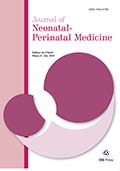Authors: Weimer, K.E.D. | Bidegain, M. | Shaikh, S.K. | Couchet, P. | Tanaka, D.T. | Athavale, K.
Article Type:
Research Article
Abstract:
BACKGROUND: Late preterm infants are at high risk for medical complications and represent a growing NICU population. While 34-weeks’ gestation infants are generally admitted to the NICU and 36-weeks’gestation infants stay in mother-baby, there is wide practice variation for 35-weeks’gestation infants. The objective of this study was to compare short-term outcomes of 35-weeks’ gestation infants born at two hospitals within the same health system (DUHS), where one (DRH) admits all 35-weeks’ gestation infants to their level II NICU and the other (DUH) admits all 35-weeks’ gestation infants to mother-baby, unless clinical concern. METHODS: We conducted a retrospective cohort
…analysis of 35-weeks’ gestation infants born at DUHS from 2014–2019. Infant specific data were collected for birth, demographics, medications, medical therapies, LOS, ED visits and readmissions. 35-weeks’ gestation infants at each hospital (DRH vs DUH) that met inclusion criteria were compared, regardless of unit(s) of care. RESULTS: 726 infants of 35-weeks’ gestation were identified, 591 met our inclusion criteria (DUH –462, DRH –129). Infants discharged from DRH were more likely to receive medical therapies (caffeine, antibiotics, blood culture, phototherapy, NGT), had a 4 day longer LOS, but were more likely to feed exclusively MBM at discharge. There were no differences in ED visits; however, more infants from DUH were readmitted within 30 days of discharge. CONCLUSIONS: Our findings suggest admitting 35-weeks’ gestation infants directly to the NICU increases medical interventions and LOS, but might reduce hospital readmissions.
Show more
Keywords: 35 weeks’ gestation, late preterm infant, length of stay, mother-baby, NICU, readmission
DOI: 10.3233/NPM-221015
Citation: Journal of Neonatal-Perinatal Medicine,
vol. 15, no. 3, pp. 643-651, 2022
Price: EUR 27.50





